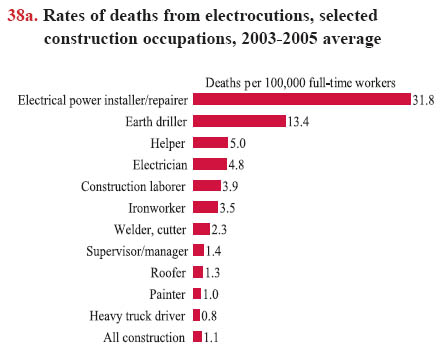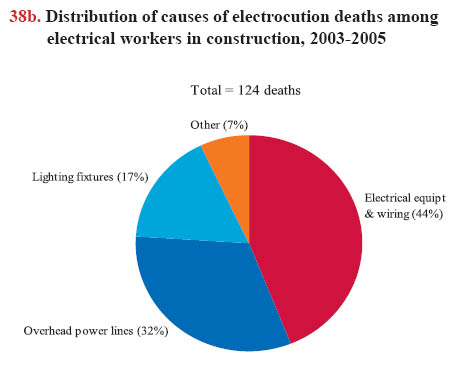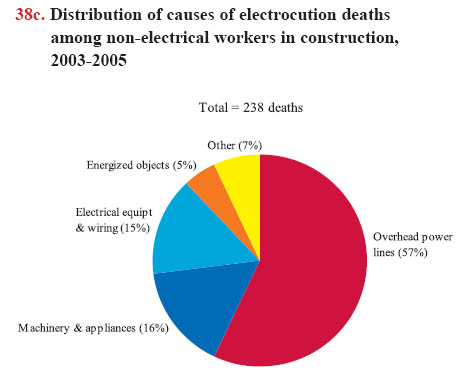Summary Statement
A broad collection of tables and charts covering health and safety in the U.S. construction industry, as well as considerable economic and training data.
2007
Section 38: Deaths from Contact with Electricity
Data from the U.S. Bureau of Labor Statistics (BLS) show that electrocution was the fourth leading cause of death in construction in 2005, after falls to a lower level, transportation injuries, and being struck by objects and equipment. Electrocutions caused 9% of 1,243 construction worker deaths, but accounted for less than 1% of reported recordable nonfatal injuries in 2005.1,2
For 2003-2005, the death rate from electrocutions for the construction industry was 1.1 per 100,000 full-time workers. For 2003-2005, there was an average of 121 electrocutions per year. The highest rates of death from electrocution were among electrical power installers and repairers and earth drillers (chart 38a). The construction occupations with the highest average number of deaths per year due to electrocution were electricians (29), construction laborers (19), supervisors/managers (13), electrical power installers and repairers (10).The causes of electrocutions in construction are different for electrical workers (electricians, electrical power installers and repairers, their apprentices and helpers doing electrical work, and their supervisors) and non-electrical workers. The main cause of electrocution of electrical workers in 2003-2005 was contact with "live" (energized) equipment and wiring (chart 38b). In more than half of electrical worker electrocutions, the hazard resulted because of a failure to de-energize and lock out or tag out electrical circuits and equipment. The high percentage of electrocutions caused by work on live light fixtures, especially 277-volt circuits, is particularly noteworthy.3
For non-electrical workers, the main cause of electrocution was contact with overhead power lines, accounting for more than half of these deaths (chart 38c). Only one-fifth of overhead power line electrocutions were due to direct contact of the worker's body with the live power line; the rest resulted when workers contacted objects or machinery – especially ladders, poles, and cranes – which were in direct contact with the power line. Working too close to energized electrical equipment and wiring, failure to lock out or tag out machinery and appliances before working on them, lack of ground fault circuit interrupters, and contact with objects energized by power sources other than overhead power lines were also causes of electrocutions.
Overall, contact with overhead power lines was the main cause of electrocutions from 2003-2005, causing a total of 177 deaths (49%), or about 60 per year. Electrical workers overall had the greatest percentage of electrocutions, followed by construction laborers (chart 38d). Heavy equipment operators (including operating engineers, crane and tower operators, excavating and loading machine operators, etc.) experienced a very small percentage of electrocutions from overhead power lines.
The types of electrical injuries include electric shocks, electrical burns (from contact with electrical current), heat burns (from arc flashes), arc blast effects (hearing loss and physical injury), and falls (as a result of electric shocks). Among electrical injuries, electric shock causes the most deaths. From 2003-2005, 362 deaths were caused by electric shock, compared with the other cause of electricity-related death, arc flashes or blasts, which resulted in 11 deaths. Arc flashes occur when a large electric current flows outside its intended path (for example, during a short circuit), passes through the air, and heats the air to temperatures as high as 35,000 degrees Fahrenheit. These conditions can also result in an explosion (arc blast).




Download MS PowerPoint versions of Charts
1. U.S. Bureau of Labor Statistics, Table A9, www.bls.gov/iif/oshwc/cfoi/cftb0213.pdf (Accessed November 2007).
2. U.S. Bureau of Labor Statistics, Table R64, www.bls.gov/iif/oshcdnew.htm (Accessed November 2007).
3. U.S. Bureau of Labor Statistics, 2003-2005 Census of Fatal Occupational Injuries. Calculations by Michael McCann, CPWR.
Note:
Chart 38a - Full-time work is defined as 2,000 hours worked per year. In 2003-2005, there was a total of 362 electrocutions. Number of deaths in each category: electrical power installer, 30; earth drillers, 7; construction helpers, 16; electricians, 88; construction laborers, 57; ironworkers, 5; welders and cutters, 7; supervisors/managers, 38; roofers, 9; painters, 17; and heavy truck drivers, 5. Occupational categories are as follows: electrical power installers/repairers, earth drillers, electricians (including apprentices), construction helpers (includes roofer helpers and electrician helpers). Roofers, truck drivers, and painters include only those trades. Ironworkers include only structural metal workers. Supervisors/managers include only first-line supervisors/managers of construction trades.
Source: All charts - U.S. Bureau of Labor Statistics, 2003-2005 Census of Fatal Occupational Injuries and the Current Population Survey. Calculations by Michael McCann and CPWR Data Center.
Back to Table of Contents


